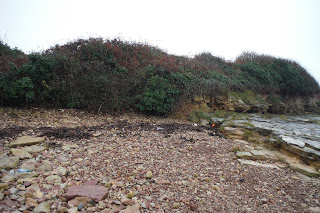Alney Island
Between Christmas and New Year we decided to tick off 2 more
islands, one to complete the years quota and the other to give us a start-
motivation for 2017 -as well as a means to shake off the Christmas lethargy!
We stopped at the White Hart in Maisemore near Gloucester
for lunch. They kindly let us leave our car there while we did the walk which
started just the other side of the bridge yards from the pub. The White Hart
seemed a typical village pub, almost empty when we arrived, with a blazing fire
in a grand fireplace. Incongruously it was run by a friendly oriental man and
doubled as a Chinese restaurant in the evenings though it was typical pub fare
at lunchtime.
Alney Island has been formed by the splitting of the River
Severn. Turning left from the pub we crossed the 1950’s bridge and took the
cycle path. This had warnings that the path was closed due to damage on the
bridge which puzzled us as we didn’t need to cross any bridges to go around the
island. We decided to give it a go anyway. It was a tarmac path with the river
on our right and a busy main road on our left, with a bit of scrubland in
between, where bikes were encouraged to make a detour!
We passed a sign that measured the depth of floodwater up to
6 feet then came to the broken bit of the path- Hardly a bridge, more a
platform. Rickety planks were positioned over the space so not suitable for
wheelchairs but fine if you were careful. People walking the other way told us
this had been like this for some time and they wish it would get fixed soon.
The sounds of a pheasant shoot ( most probably) were loud
and spasmodic. We caught glimpses of deerstalker hats bobbing behind the trees
round the field over the river. After the walk the pub car park full of big
people carriers and hearty country types heralded the close of day.
It was under a wide road bridge, concrete and well
graffitied then a rather grand bridge built by Thomas Telford in stone spanned
the river to our right. Altogether around Alney we counted 10 bridges!
The cycleway went to the left and we walked the footpath
around the Nature Reserve- meadowland. There was a field of sedge like plants
that had been cut into- maybe used for thatching. From here we could see the
cathedral though the view was spoilt by pylons partially obscuring it. Then we
reached Lower Parting where the Severn parts around the island and where the
Severn Bore can be best viewed-about 2 metres high. We think someone watching
it here might get quite wet judging by the high level of the river debris up
the banks.
We had to cross several little bridges over what would be
marshy ground sometimes though the frosty ground made it firm today. Only where
the sun, glorious in a blue sky, impacted on the ground was there a slippery
patch of mud. I skidded twice! The sun being low made it difficult to identify birdlife
even with binoculars.
The path took us through dry Llanthony Lock, narrow, walled
and because it was in shadow, white underfoot. The only building so far was on
its banks – the lock keepers house, rather large and now privately owned.
A little further we dipped under a derelict iron railway
bridge, rusting to pieces literally. Then we were opposite the dock area and
various riverside businesses. A large healthy looking fox caught our gaze and
stared back for some time, in between the back of some buildings and the river,
obviously his domain.
There were mown grassy areas now and several possibilities
for a route but we headed under yet more bridges. As we walked we met a man who
said in the 1970s he had worked on this first bridge- a replacement and he
never got his holiday pay a fact he still felt bitter about!
We were now in the city of Gloucester and needed to get to
the river bank but a fairground’s parking area blocked the way. We walked in
and out of a few roads passing a lovely mosaic wall- some people are very
creative. Trying to stay parallel with the river we came to the road then a
field with a footpath sign. There were many old breed cattle here- bullocks and
one highly muscled with a ring through his nose. They weren’t scared of us and
blocking our way forward. Their horns looked honed and dangerous. Opting for
the tunnel with the lesser beast without the ring we gingerly edged by and only
allowed ourselves to breathe again when we had closed the gate on them.
After walking a little further we found ourselves back at
the Telford bridge and we knew where we were though we would have preferred not
to have retraced our steps at all. We met the same couple returning also, who
told us the cattle are big softees, but we saw the rips in the corrugated iron
shed which looked very battered and bashed at horn height!
We had been walking about 2 hours and we didn’t have a drink
in the pub as light was beginning to fade.We pressed on,our next stop was being
the Premier Inn at Barry and Sully Island tomorrow.




























